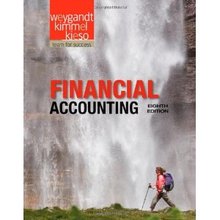This is completed downloadable of Financial Accounting Weygandt 8th Edition Test Bank

Product Details:
ISBN 10: 1118484320
ISBN 13: 9781118484326
Author:
Strayer University ACC557 – Book Only
Table of Content:
1 Introduction to Financial Statements 2
Knowing the Numbers 3
LO 1: Study the forms of business organization and the uses of accounting information 4
Forms of Business Organization 4
Users and Uses of Financial Information 5
Ethics in Financial Reporting 7
LO 2: Explain the three principal types of business activity 8
Financing Activities 9
Investing Activities 9
Operating Activities 9
LO 3: Describe the four financial statements and how they are prepared 11
Income Statement 11
Retained Earnings Statement 12
Balance Sheet 13
Statement of Cash Flows 14
Interrelationships of Statements 15
Other Elements of an Annual Report 18
A Look at IFRS 42
2 A Further Look at Financial Statements 46
Just Fooling Around? 45
LO 1: Identity the sections of a classified balance sheet 46
Current Assets 46
Long-Term Investments 48
Property, Plant, and Equipment 48
Intangible Assets 48
Current Liabilities 50
Long-Term Liabilities 50
Stockholders’ Equity 50
LO 2: Use ratios to evaluate a company’s profitability, liquidity, and solvency 51
Ratio Analysis 51
Using the Income Statement 52
Using a Classified Balance Sheet 53
Using the Statement of Cash Flows 57
LO 3: Discuss financial reporting concepts 58
The Standard-Setting Environment 58
Qualities of Useful Information 59
Assumptions in Financial Reporting 60
Principles in Financial Reporting 61
Cost Constraint 62
A Look at IFRS 87
3 The Accounting Information System 90
Accidents Happen 91
LO 1: Analyze the effect of business transactions on the basic accounting equation 92
Accounting Transactions 92
Analyzing Transactions 93
Summary of Transactions 99
LO 2: Explain how accounts, debits, and credits are used to record business transactions 100
Debits and Credits 101
Debit and Credit Procedures 101
Stockholders’ Equity Relationships 104
Summary of Debit/Credit Rules 105
LO 3: Indicate how a journal is used in the recording process 106
The Recording Process 106
The Journal 106
LO 4: Explain how a ledger and posting help in the recording process 109
The Ledger 109
Chart of Accounts 109
Posting 110
The Recording Process Illustrated 111
Summary Illustration of Journalizing and Posting 117
LO 5: Prepare a trial balance 119
Limitations of a Trial Balance 119
A Look at IFRS 148
4 Accrual Accounting Concepts 46
Keeping Track of Groupons 151
LO 1: Explain the accrual basis of accounting and the reasons for adjusting entries 152
The Revenue Recognition Principle 152
The Expense Recognition Principle 152
Accrual versus Cash Basis of Accounting 153
The Need for Adjusting Entries 154
Types of Adjusting Entries 155
LO 2: Prepare adjusting entries for deferrals 156
Prepaid Expenses 156
Unearned Revenues 160
LO 3: Prepare adjusting entries for accruals 163
Accrued Revenues 163
Accrued Expenses 164
Summary of Basic Relationships 167
LO 4: Prepare an adjusted trial balance and closing entries 170
Preparing the Adjusted Trial Balance 170
Preparing Financial Statements 171
Quality of Earnings 172
Closing the Books 175
Summary of the Accounting Cycle 177
LO *5: Appendix 4A: Describe the purpose and the basic form of a worksheet 182
A Look at IFRS 212
5 Merchandising Operations and the Multiple-Step Income Statement 150
Buy Now, Vote Later 215
LO 1: Describe merchandising operations and inventory systems 216
Operating Cycles 216
Flow of Costs 217
LO 2: Record purchases under a perpetual inventory system 219
Freight Costs 221
Purchase Returns and Allowances 221
Purchase Discounts 222
Summary of Purchasing Transactions 223
LO 3: Record sales under a perpetual inventory system 224
Sales Returns and Allowances 225
Sales Discounts 226
LO 4: Prepare a multiple-step income statement and a comprehensive income statement 227
Single-Step Income Statement 227
Multiple-Step Income Statement 228
Comprehensive Income Statement 231
LO 5: Determine cost of goods sold under a periodic inventory system 233
LO 6: Compute and analyze gross profit rate and profit margin 234
Gross Profit Rate 234
Profit Margin 235
LO *7: Appendix 5A: Record purchases and sales of inventory under a periodic inventory system 239
Recording Merchandise Transactions 239
Recording Purchases of Merchandise 239
Freight Costs 240
Recording Sales of Merchandise 240
Comparison of Entries—Perpetual vs. Periodic 241
A Look at IFRS 264
6 Reporting and Analyzing Inventory 266
“Where Is That Spare Bulldozer Blade?” 267
LO 1: Discuss how to classify and determine inventory 268
Classifying Inventory 268
Determining Inventory Quantities 269
LO 2: Apply inventory cost flow methods and discuss their financial effects 271
Specific Identification 272
Cost Flow Assumptions 273
Financial Statement and Tax Effects of Cost Flow Methods 277
Using Inventory Cost Flow Methods Consistently 280
LO 3: Explain the statement presentation and analysis of inventory 281
Presentation 281
Lower-of-Cost-or-Market 281
Analysis 283
Analysts’ Adjustments for LIFO Reserve 284
LO *4: Appendix 6A: Apply inventory cost flow methods to perpetual inventory records 287
First-In, First-Out (FIFO) 287
Last-In, First-Out (LIFO) 288
Average-Cost 289
LO *5: Appendix 6B: Indicate the effects of inventory errors on the financial statements 289
Income Statement Effects 289
Balance Sheet Effects 290
A Look at IFRS 314
7 Fraud, Internal Control, and Cash 316
Minding the Money in Madison 317
LO 1: Define fraud and the principles of internal control 318
Fraud 318
The Sarbanes-Oxley Act 318
Internal Control 319
Principles of Internal Control Activities 320
Limitations of Internal Control 326
LO 2: Apply internal control principles to cash 327
Cash Receipts Controls 328
Cash Disbursements Controls 330
LO 3: Apply the control features of a bank account 333
Electronic Funds Transfer (EFT) System 333
Bank Statements 333
Reconciling the Bank Account 334
LO 4: Explain the reporting of cash and the basic principles of cash management 340
Reporting Cash 340
Managing and Monitoring Cash 341
Cash Budgeting 344
LO *5: Appendix 7A: Explain the operation of a petty cash fund 347
Establishing the Petty Cash Fund 347
Making Payments from Petty Cash 347
Replenishing the Petty Cash Fund 348
A Look at IFRS 371
8 Reporting and Analyzing Receivables 374
What’s Cooking? 375
LO 1: Explain how companies recognize accounts receivable 376
Types of Receivables 376
Recognizing Accounts Receivable 376
LO 2: Describe how companies value accounts receivable and record their disposition 378
Valuing Accounts Receivable 378
Disposing of Accounts Receivable 385
LO 3: Explain how companies recognize, value, and dispose of notes receivable 387
Determining the Maturity Date 388
Computing Interest 388
Recognizing Notes Receivable 388
Valuing Notes Receivable 389
Disposing of Notes Receivable 389
LO 4: Describe the statement presentation of receivables and the principles of receivables management 391
Financial Statement Presentation of Receivables 391
Managing Receivables 392
Evaluating Liquidity of Receivables 394
Accelerating Cash Receipts 396
A Look at IFRS 419
9 Reporting and Analyzing Long-Lived Assets 422
A Tale of Two Airlines 423
LO 1: Explain the accounting for plant asset expenditures 424
Determining the Cost of Plant Assets 424
Expenditures During Useful Life 427
To Buy or Lease? 428
LO 2: Apply depreciation methods to plant assets 429
Factors in Computing Depreciation 430
Depreciation Methods 430
Revising Periodic Depreciation 435
Impairments 436
LO 3: Explain how to account for the disposal of plant assets 437
Sale of Plant Assets 437
Retirement of Plant Assets 438
LO 4: Identity the basic issues related to reporting intangible assets 439
Accounting for Intangible Assets 440
Types of Intangible Assets 440
LO 5: Discuss how long-lived assets are reported and analyzed 443
Presentation 443
Analysis 444
LO *6: Appendix 9A: Compute periodic depreciation using the declining-balance method and the units-of-activity method 449
Declining-Balance Method 449
Units-of-Activity Method 450
A Look at IFRS 475
10 Reporting and Analyzing Liabilities 478
And Then There Were Two 479
LO 1: Explain how to account for current liabilities 480
What Is a Current Liability? 480
Notes Payable 480
Sales Taxes Payable 481
Unearned Revenues 481
Current Maturities of Long-Term Debt 482
Payroll and Payroll Taxes Payable 483
LO 2: Describe the major characteristics of bonds 485
Types of Bonds 486
Issuing Procedures 486
Determining the Market Price of Bonds 486
LO 3: Explain how to account for bond transactions 489
Issuing Bonds at Face Value 489
Discount or Premium on Bonds 489
Issuing Bonds at a Discount 490
Issuing Bonds at a Premium 492
Redeeming Bonds at Maturity 493
Redeeming Bonds before Maturity 493
LO 4: Discuss how liabilities are reported and analyzed 495
Presentation 495
Analysis 496
LO *5: Appendix 10A: Apply the straight-line method of amortizing bond discount and bond premium 502
Amortizing Bond Discount 502
Amortizing Bond Premium 503
LO *6: Appendix 10B: Apply the effective-interest method of amortizing bond discount and bond premium 504
Amortizing Bond Discount 505
Amortizing Bond Premium 506
LO *7: Appendix 10C: Describe the accounting for long-term notes payable 507
A Look at IFRS 534
11 Reporting and Analyzing Stockholders’ Equity 536
Oh Well, I Guess I’ll Get Rich 537
LO 1: Discuss the major characteristics of a corporation 538
Characteristics of a Corporation 538
Forming a Corporation 541
Stockholder Rights 541
Stock Issue Considerations 542
Corporate Capital 544
LO 2: Explain how to account for the issuance of common and preferred stock, and the purchase of treasury stock 545
Accounting for Common Stock 545
Accounting for Preferred Stock 546
Treasury Stock 547
LO 3: Explain how to account for cash dividends and describe the effect of stock dividends and stock splits 549
Cash Dividends 549
Dividend Preferences 552
Stock Dividends 553
Stock Splits 555
LO 4: Discuss how stockholders’ equity is reported and analyzed 557
Retained Earnings 557
Retained Earnings Restrictions 558
Balance Sheet Presentation of Stockholders’ Equity 558
Analysis of Stockholders’ Equity 560
Debt versus Equity Decision 562
LO *5: Appendix 11A: Prepare entries for stock dividends 565
A Look at IFRS 587
12 Statement of Cash Flows 590
Got Cash? 591
LO 1: Discuss the usefulness and format of the statement of cash flows 592
Usefulness of the Statement of Cash Flows 592
Classification of Cash Flows 592
Significant Noncash Activities 593
Format of the Statement of Cash Flows 594
LO 2: Prepare a statement of cash flows using the indirect method 595
Indirect and Direct Methods 596
Indirect Method—Computer Services Company 596
Step 1: Operating Activities 598
Summary of Conversion to Net Cash Provided by Operating Activities–Indirect Method 601
Step 2: Investing and Financing Activities 603
Step 3: Net Change in Cash 604
LO 3: Use the statement of cash flows to evaluate a company 607
The Corporate Life Cycle 607
Free Cash Flow 609
LO *4: Appendix 12A: Prepare a statement of cash flows using the direct method 611
Step 1: Operating Activities 613
Step 2: Investing and Financing Activities 617
Step 3: Net Change in Cash 618
LO *5: Appendix 12B: Use the T-account approach to prepare a statement of cash flows 618
A Look at IFRS 643
13 Financial Analysis: The Big Picture 646
It Pays to Be Patient 647
LO 1: Apply the concept of sustainable income and quality of earnings 648
Sustainable Income 648
Quality of Earnings 652
LO 2: Apply horizontal analysis and vertical analysis 654
Horizontal Analysis 655
Vertical Analysis 657
LO 3: Analyze a company’s performance using ratio analysis 660
Price-Earnings Ratio 660
Liquidity Ratios 660
Solvency Ratios 661
Profitability Ratios 661
LO *4: Appendix 13A: Evaluate a company comprehensively using ratio analysis 666
Liquidity Ratios 668
Solvency Ratios 670
Profitability Ratios 672
A Look at IFRS 699
A Specimen Financial Statements: Apple Inc. A-1
B Specimen Financial Statements: Columbia Sportswear Company B-1
C Specimen Financial Statements: VF Corporation C-1
D Specimen Financial Statements: Amazon.com, Inc. D-1
E Specimen Financial Statements: Wal-Mart Stores, Inc. E-1
F Specimen Financial Statements: Louis Vuitton F-1
G Time Value of Money G-1
LO 1: Compute interest and future values G-1
Nature of Interest G-1
Future Value of a Single Amount G-3
Future Value of an Annuity G-4
LO 2: Compute present values G-7
Present Value Variables G-7
Present Value of a Single Amount G-7
Present Value of an Annuity G-9
Time Periods and Discounting G-11
Present Value of a Long-Term Note or Bond G-11
LO 3: Use a financial calculator to solve time value of money problems G-13
Present Value of a Single Sum G-14
Present Value of an Annuity G-15
Useful Applications of the Financial Calculator G-15
H Reporting and Analyzing Investments H-1
LO 1: Explain how to account for debt investments H-1
Why Corporations Invest H-1
Accounting for Debt Investments H-3
LO 2: Explain how to account for stock investments H-4
Holdings of Less than 20% H-4
Holdings Between 20% and 50% H-5
Holdings of More than 50% H-6
LO 3: Discuss how debt and stock investments are reported in the financial statements H-7
Categories of Securities H-7
Balance Sheet Presentation H-10
Presentation of Realized and Unrealized Gain or Loss H-11
Statement of Cash Flows Presentation H-12
Company Index I-1
Subject Index I-5
People Also Search:
financial accounting weygandt 8th edition
financial accounting weygandt 8th edition test bank download pdf
financial accounting weygandt 8th edition download scribd





